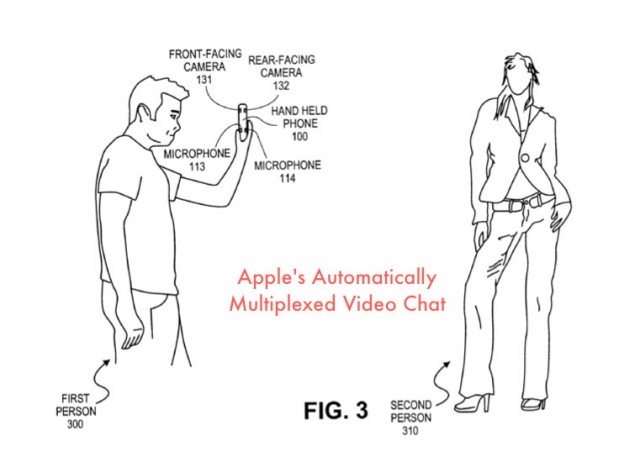
Pretty soon, you will be able to record a live 2-person conversation or interview with your iPhone – and your iPhone will automatically switch live between the talking heads to record a multiplexed video stream.
In a patent application filed with the USPTO in January of this year, Apple disclosed an invention whereby an iPhone with dual cameras (one front-facing and one rear-facing) will record dual video streams “and based on detection of the speech activity, automatically switch[es] between the first video stream and the second video stream to generate a multiplexed video stream.”
Apples says it will use both audio and visual cues to decide which camera needs to be active at a given time.
. . . . detecting a speech activity of a person comprises: detecting a direction of the sound with at least two microphones that point to different directions . . . . [and] analyzing an image of the face of the person captured in said one of the first and second video streams to detect the lip movement.
Not only will it record the multiplex stream of people on either side of the iPhone, but Apple also considers the use of the multiplex stream in video chatting with remote users. As a result, you can have a 3-way video chat with two people on one end and the third-party sees only the person who is talking, which means you wouldn’t have to manually switch from front to back cameras.
Of course, this being a patent application, there’s no sure fire time frame on when (or even if) we will see this in a future iPhone. However, this tech doesn’t seem so far on the other side of the horizon that it can’t happen soon.
What other uses can you see for multiplexed video capture in an iPhone?






Forgive my ignorance regarding all things patent related, but when Apple, or any other company, applies for a patent does said company have to provide more than just the idea with a flow chart indicating how such a system would work?
I mean, does said company actually need to provide very exact and particular concepts, schematics, blueprints of components, etc.?
If it’s as easy as the diagrams indicate then couldn’t I submit an idea for a Star Trek styled transporter, complete with diagrams and notes like “And then atoms are reassembled at designated target” type nonsense?
In order to successfully claim a patent on a give invention, there are 5 core requirements that must be fulfilled: (1) patentable subject matter, (2) novelty, (3) utility, (4) nonobviousness, and (5) enablement. Each of these core requirements are unique legal standards with large bodies of case law that define their scope. Each of these do their part to weed out trash applications (like a Star Trek transporter), and then these are very hotly contested in many legitimate applications and subsequent disputes among rivals.
For the “enablement” prong of the application process, companies like Apple have to demonstrate the work that (1) it has invented the described idea (such that it is actually in possession of the invention at the time of the application and (2) the description must be sufficiently clear to enable those who are “skilled in the art” to make and use the invention.
So, yes, it has to be more of a flow chart of how the system would/could work. I generally lift the flow charts and diagrams from the applications because these communicate the idea to the average reader better than blocks of verbose text in patent claims. I also try to break down the general nature of the patent application without getting into too much of the technical detail and legal claims, and guesstimate where and why it will be useful to the end consumer.